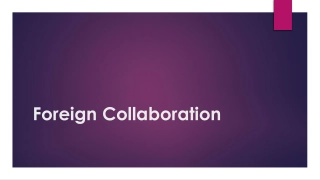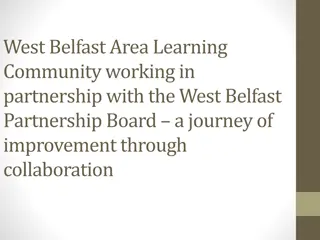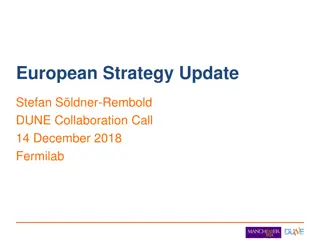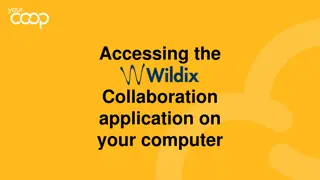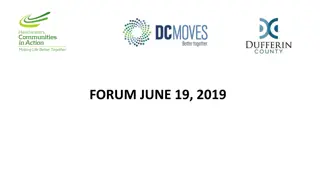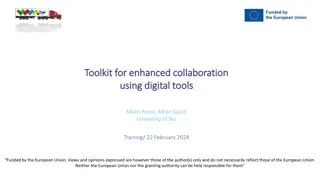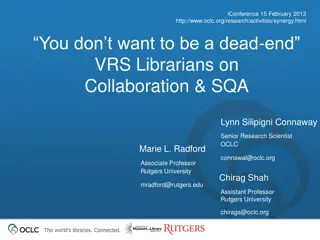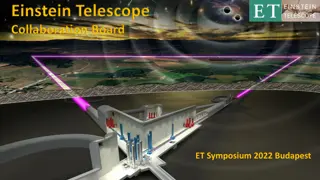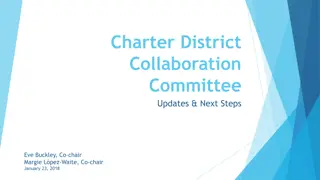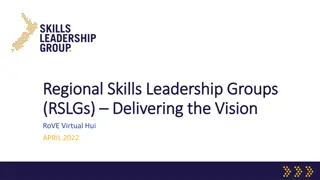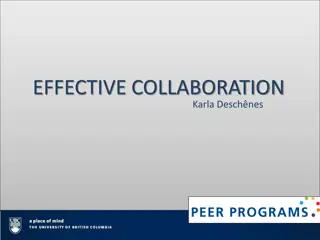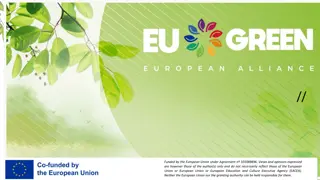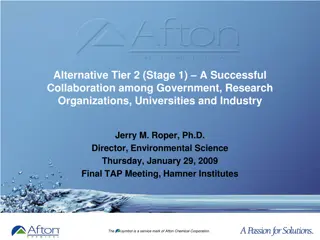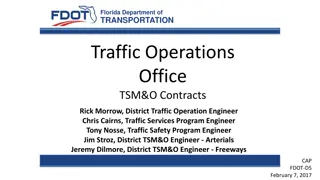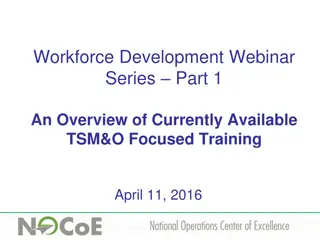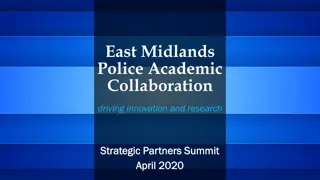TSM&O Collaboration Challenges and Opportunities
Addressing challenges in Transportation Systems Management and Operations (TSM&O) such as congestion and delays, this webinar series focuses on mainstreaming continuous improvement through collaboration and leveraging FHWA Capability Maturity Model. Explore dimensions of capability and best practices for effective TSM&O strategies.
Uploaded on Mar 16, 2025 | 0 Views
Download Presentation

Please find below an Image/Link to download the presentation.
The content on the website is provided AS IS for your information and personal use only. It may not be sold, licensed, or shared on other websites without obtaining consent from the author.If you encounter any issues during the download, it is possible that the publisher has removed the file from their server.
You are allowed to download the files provided on this website for personal or commercial use, subject to the condition that they are used lawfully. All files are the property of their respective owners.
The content on the website is provided AS IS for your information and personal use only. It may not be sold, licensed, or shared on other websites without obtaining consent from the author.
E N D
Presentation Transcript
Transportation Systems Management and Operations (TSM&O) Collaboration based on FHWA Capability Maturity Model Workshops 1
The Challenges/Opportunities for TSM&O Challenges Congestion and delay are increasing as economic and population growth continue but existing roadways have capacity constraints. A high value is placed on the reliability of the system. Reviewing the existing TSM&O versus state of practice: Unsystematic Pockets of excellence Opportunities Unexploited potential of aggressive, integrated, collaborative TSM&O applied to existing roadways. Agencies can develop the key capacities needed to improve TSM&O effectiveness. 2
What This Series of Webinars Is About Objective: Mainstreaming continuous improvement in TSM&O Background: Major program of SHRP2 research and over 40 FHWA-sponsored State DOT workshops Workshop Process: Agency self-evaluation and improvement plans, with capability maturity model White Papers are available covering: State of the practice regarding agency capabilities Current agency approaches for improvement www.ops.fhwa.dot.gov/plan4ops/focus_areas/organiz ing_for_op.htm 3
This Webinar Part of a series of six (available on web (http://www.transportationops.org/ This presentation 1. Background (6 slides) on concept of Capability Maturity 2. Focus on Collaboration: workshop findings, actions determined by workshops 3. 3 Best Practice case studies by workshop participants 4. Your Questions 4
The Dimensions of Capability Effective TSM&O Strategies Systems and Performance Measurement Technology Business and technical processes support strategies Business Processes Capabilities Organization and relationships support processes Collaboration Organization and Staffing Culture 5
The 6 Dimensions of CMM Business Processes, including planning, programming and budgeting (resources) and project development and procurement. 1. Systems and Technology, including use of systems engineering, concepts of operations, systems architecture standards, interoperability, and standardization. 2. Performance Measurement, including measures definition, data acquisition, analytics, communication and utilization. 3. Culture, including technical understanding and business case, leadership, outreach, and program legal authority. 4. Organization and Staffing, including programmatic status, organizational structure and accountability, staff capabilities, training/development, and recruitment and retention. 5. Collaboration, including relationships with public safety agencies, local governments, MPOs, and the private sector. 6. 6
The Path to Excellence in State DOT TSM&O What capabilities? To Here CAPABILITIES From Here How to Improve? TIME 7
The Capability Maturity Model Goal for the Future LEVEL 4 Optimized Performance-based improvement Formal program Formal partnerships LEVEL 3 Most Agencies Today Integrated Process documented Performance measured Organization/ partners aligned Program budgeted LEVEL 2 Managed Processes developing Staff training Limited accountability LEVEL 1 Performed Activities & relationships ad hoc Champion-driven 8
What is Collaboration Dimension ? Program Status Collaboration refers to cooperative arrangements between two or more entities working together to achieve shared goals, including: Public-public cooperation with other levels of government/MPOs (jurisdiction, resources) Public-public with the public safety community (jurisdiction, resources) Public-Private collaboration through outsourcing partnerships. Note: Internal collaboration among units within an agency is also important and dealt with in the Organization and Staffing dimension 9
Why is Collaboration Important? State DOT legacy Agency legacy programs (e.g., construction and maintenance) are self-contained most activities traditionally done by staff or contracted out. TSM&O strategies are different with their own requirements: Involve other s networks (local government arterials) Depend on other agency s funding (sales taxes) Include other legal domains (law enforcement) Intersect with private sector traditions (towing and recovery) Require skills and resources not possessed by DOTs (systems engineering and data management) 10
Collaboration Dimension CMM Workshop Results The summary in slides that follow will provide: Typical state-of-play Self-improvement actions suggested by workshop participants (May help you think through applicable actions in your agency) Best Practice Case Studies which illustrate will follow NOTE: get ready with your questions!! 12
Elements of Collaboration 1. Public safety agency (law enforcement, fire and emergency medical, emergency management, and hazmat) 2. Local government transportation units and Metropolitan/Regional Planning Organizations 3. Other sector service providers: towing and recovery; systems engineering; device maintenance; planning data development/ management Traffic Management Center (TMC) workforce Safety Service Patrol (SSP), and media) 13
Collaboration: Criteria for Level Achievement Capability Level 1 Relationships ad hoc and on personal basis (public-public, public-private) Capability Level 2 Objectives, strategies, and performance measures aligned among organized central players (transportation and public safety agencies) with after-action debriefing Rationalization/sharing/formalization of responsibilities among central players through co-training, formal agreements, and incentives High level of TSM&O coordination among owner/operators (State, local, private) Capability Level 3 Capability Level 4 14
Workshop Capability Self-Assessments Capability Self-Assessment Dimension Level 1 Performed Level 2 Managed Level 3 Integrated Level 4 Optimizing Business Processes 11 10 2 0 Systems and Technology 7 12 3 1 Performance Measurement 9 11 3 0 Culture 8 11 4 0 Organization and Staffing 8 9 6 0 Collaboration 4 12 6 1 15
Element 1 Public Safety Agency Collaboration: State-of-Play Recognition that good incident management is dependent on incident command and first responders Incident command variation from state-to-state Conflicting vs overlapping priorities among stakeholders Fuzzy boundaries in roles/jurisdictions Relationship styles formal, informal 16
Element 1 Public Safety Agency Collaboration: Participants Proposed Actions Build on major programs of TIM training nationwide. Recognize need to lead from behind regarding mobility and the value of formal team-building, alignment, and co-training activities. Mainstream lessons from the highly collaborative special planned events into routine day-to-day habits. Encourage co-location and formal agreements (e.g., charters and MOUs) to improve alignment. Institutionalize post-incident debriefings and formal acceptance and use of performance measures. Utilize resource sharing to enhance alignment of agencies. New: Recognize special demands of advanced TSM&O (e.g. Integrated Corridor Management and Active Traffic Management 17
Element 2 MPO/RTPA/Local Government Collaboration: State-of-Play Planning/Programming - Wide variation Wide variation regarding MPO s TSM&O planning: few examples, but good ones!! State DOT statewide /district TSM&O planning absent and minimal input into MPO planning Operations Interoperability problems and modest sharing of video and computer aided dispatch (CAD) data with locals Advanced TSM&O strategies present challenges for local action (e.g., diversion plans, coordinated operations, architectures Limited local government staff and resource availability -- but opposite challenge in local options sales tax contexts 18
Element 2 MPO/RTPA/Local Government Collaboration: Participants Proposed Actions Set up formal agreements with other stakeholders for TSM&O (e.g., arterial owners and ICM stakeholders). Use resource-sharing contracts for efficient state and local allocation of signalization responsibility. Broadening MPO technical or operations committees to include full TSM&O strategies: planning; architecture, data Capitalize on congestion management process (CMP) data and analysis for TSM&O analysis and business case. 19
Element 3 Outsourcing/Public-Private Partnerships: State-of-Play State DOTs increasing dependence on private sector for special technical services, due to cost, staff level and capabilities constraints Varying policy environment regarding privatization Failure to address outsourcing and PPPs as permanent, manageable aspect of TSM&O Variation in arrangements: insourcing and outsourcing -- but limited peer-to-peer experience interchange Traditional procurement and contract methods are not fitting all the needs (e.g., low bid, unclear scopes, owner control, no performance Problems and issues with intellectual property rights 20
Element 3 Outsourcing/Public-Private Partnerships: Participants Proposed Actions Review core capabilities needed consistently in-house Consider implications of significant external dependency and for technically complex strategies . Utilize appropriate (not just legacy) form of PPP arrangement (e.g., scope, time span and procurement approach). Use performance incentives (not just low cost) to achieve objectives from contractor. 21
One Executive Summary (covers all dimensions) Six White Papers one on each capability dimension http://www.transportationops.org/ 22
Suggested National Activities to Address Collaboration Possible sponsorship Activities Develop guidance for formal TIM agreements with a special focus on aspects that improve their long-term viability Develop case study document regarding incentive-based towing and recovery agreements Poll State DOTs to determine extent of outsourcing; document current practices FHWA FHWA Operations Academy , NOCoE, FHWA FHWA, NOCoE Develop methods for accommodating TSM&O activities and their resource requirements in both conventional statewide and metropolitan planning Identify promising examples of collaborative operational management involving State and local entities FHWA Federal Highway Administration AASHTO American Association of State Highway and Transportation Officials NOCoE National Operations Center of Excellence FHWA, AASHTO, AMPO, NOCoE 23
What You Can Do Read the CMM reports and white papers Participate in FHWA state DOT Self-Evaluation Workshops and Regional Operations Forums Utilize NOCoE website to track developments and access resources Contact and communicate with corresponding staff in peer states 24
Questions/ Contact FHWA HQ office through your local FHWA Division offices or NOCoE dmotiani@transportationops.org 202.624.5478 25


